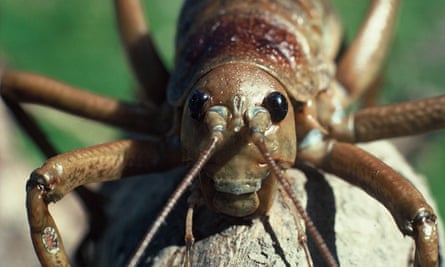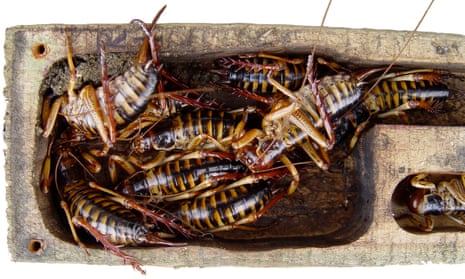In a tiny motel at the back of a Wellington garden, a group of lodgers with shiny cigar-shaped bodies and spiny legs are making themselves at home. A male is bunking in with his harem of females, their bodies huddled together, a wiry mashup of legs and antennae. Once a fortnight the motel’s owner, Holly Neill, briefly opens the door to peer into the perspex window and check on her tenants, each time experiencing the thrill of being able to spy on the shy, strange creatures inside.
They are not paying guests and nor are these ordinary motels, but rather human-made houses for one of New Zealand’s most beloved insects – the wētā. Increasingly, wētā motels are popping up in gardens as New Zealanders begin to embrace the bugs in their backyards – something that may also give the endangered species a chance at survival.
Forests, grasslands, caves and alpine terrains once crawled with wētā, but their populations have suffered with the introduction of foreign pests and increasing habitat decline due to dairy farming. Sixteen of New Zealand’s wētā species are at risk and the rest are classified as threatened or endangered. The largest species, the giant wētā (or wētāpunga), once abundant across parts of the North Island, is now found only on Hauturu-o-Toi (Little Barrier Island), a pest-free sanctuary off the east coast. The Mahoenui giant wētā, feared extinct until it was rediscovered in 1962, exists only in a patch of King Country gorse.

Photograph: Gary Webber/Alamy Stock Photo
“I think people hold them in high regard and it’s almost a point of pride to have wētā in the garden,” says Neill, a keen conservationist and wildlife photographer.
“It adds another dimension of appreciation of nature if you’re including the small, more secretive bugs that come out at night.”
Wētā belong to the same group of insects as crickets and grasshoppers, and there are between 70 and 100 species of wētā endemic to New Zealand. They are wingless and nocturnal, and some, including the wētāpunga, are among the heaviest insects in the world – comparable to the weight of a sparrow.

Neill installed two wētā motels on native kānuka trunks at the back of her Raumati Beach garden just over a year ago, after discovering the motels at “loads of different sanctuaries”. Within three months she had her first guests. At one point she opened a motel to find a wētā, a native cockroach and a bumblebee in the same chamber. “I felt like I was interrupting a bug meeting,” Neill laughs.
When she first moved into the property, the garden was overrun with agapanthus plants and weeds, where she found just three spiders lurking. She cleared it, set traps for predators, planted native trees and installed the motels. “I was shocked at how barren it was and then, since doing this, all the rooms are full [of wētā]. It shows quite a rapid change.”
‘A window on the world’
The motels are made of non-treated wood and are designed to have entrance and exit tunnels large enough for the wētā to crawl into but small enough that a mouse cannot. To attract wētā, they must be dark during the day.
“If you were to split a log and look at what they naturally do, it’s pretty similar to that,” says Steve Rawson of Swiss Wood Technicians. He began making wētā homes in 2016 for the Department of Conservation, and in 2018 started selling them to the public, becoming one of many small retailers or community groups now doing so. Sales have plodded along, but in the lead-up to last Christmas, they sold roughly 40 motels – double that of the year prior.
“We’ve noticed a real increase in sales, especially in the Wellington area,” Rawson says, something he credits to education programmes at Wellington’s urban sanctuary Zealandia. “Before that, I think a lot of people would look at wētā and think ‘Yuck, I don’t want to go near them’, but they are actually amazing creatures and they are not that horrifying at all.”
The motels (sometimes called hotels or condos) were originally conceived as a research aide around 1994 by Massey University ecologist and wētā expert Steve Trewick – a scientist so dedicated to the insect, that a tree wētā, the Hemideina trewicki, was named after him.
Trewick was trying to ascertain the distribution of wētā in the environment – a difficult task when dealing with a secretive, nocturnal creature – when he discovered two species sharing a dead tree trunk. “From that observation, I said, well, let’s just make our own versions of that because then we can open them up and see how many males or females are present.”
A growth in higher education and deepening awareness of conservation problems could be prompting more interest in wētā and how to care for them, says Warren Chinn, an invertebrate ecologist at the Department of Conservation. “I would also say that social media and the internet has been an extraordinary boon to consciousness of conservation values.
“These things have become really successful – the animal doesn’t know that it’s artificial, they just know that it’s suitable.”
The motels are “undoubtedly” helpful for wētā populations, particularly in urban environments, Trewick adds, and the growth in understanding biodiversity, and caring for it, has knock-on effects for boosting other species.
But the crossover of wētā motels into private backyards achieves more than helping protect wētā populations; they are also sating the curiosity of creepy-crawly fans.
“I think that the most useful thing about the motels is that people see that there is much more to the biology of our planet than they would otherwise see. Most New Zealand biology is out and about at night. It’s a window on the world,” Trewick says.
They are fascinating creatures to observe, Chinn adds: “If you open up the doors on the big ones … there is a density of these monsters and their great prickly legs. That is delightfully horrific.”
